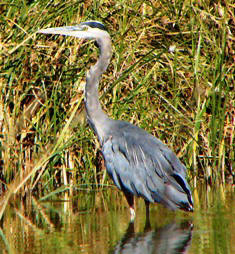One of my favorite
Florida birds is the Great Blue heron. It can be found along the ocean shore or the
edge of a small inland pond. An all white form is found from southern
Florida into the Caribbean, and used to be considered a separate
species, the "Great White Heron." The white form of the Great Blue
Heron, known as the "great white heron," is found nearly exclusively in
shallow marine waters along the coast of very southern Florida, the
Yucatan Peninsula, and in the Caribbean. Where the dark and white forms
overlap in Florida, intermediate birds known as "Wurdemann's herons" can
be found. They have the bodies of a Great Blue Heron, but the white head
and neck of the great white heron. Although the Great Blue Heron eats
primarily fish, it is adaptable and willing to eat other animals as
well. Several studies have found that voles (mice) were a very important
part of the diet, making up nearly half of what was fed to nestlings in
Idaho. Occasionally a heron will choke to death trying to eat a fish
that is too large to swallow.
My husband just finished a new painting and it has a heron in it.
Withlacoochee Heron was painted in the style of the impressionists
with loose lines that allow the eye to fill in the blurred areas. This
painting was not done in plein aire like the impressionists but we did
visit the spot and take multiple photographs. The Withlacoochee River originates in central
Florida's Green Swamp, east of Polk City. It flows west, then north,
and then turns northwest and finally west again before it empties into
the Gulf of Mexico near Yankeetown. The river is 86 miles long and has
a drainage basin of 1,170 square miles. "Withlacoochee" probably stems
from a Muskhogean dialect. It is compounded of Creek we (water)thlako
(big), and chee (little), or little big water. This word
combination signifies little river in the Creek language, and as
we-lako or wethlako may also refer to a lake, it may
signify a river of lakes, or lake river. This area is near Dunnellon and
was viewed while he was walking on the Rails to Trails.



Comments
Post a Comment